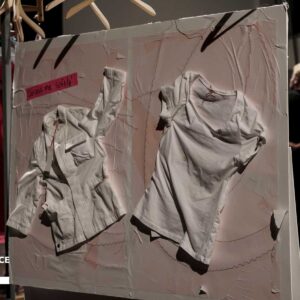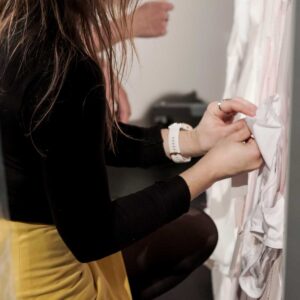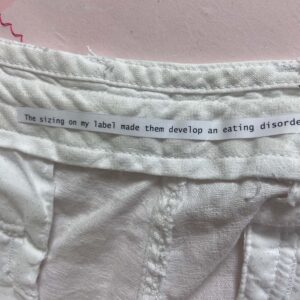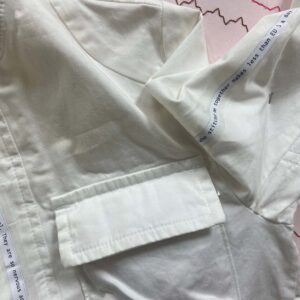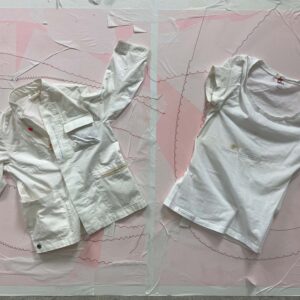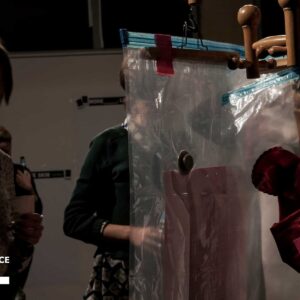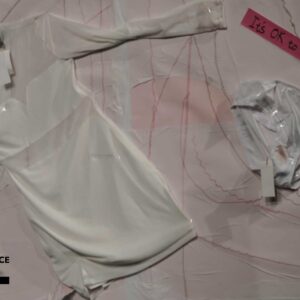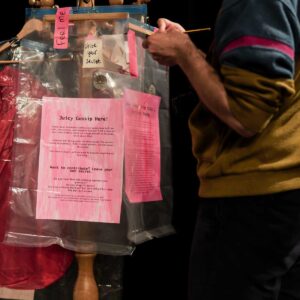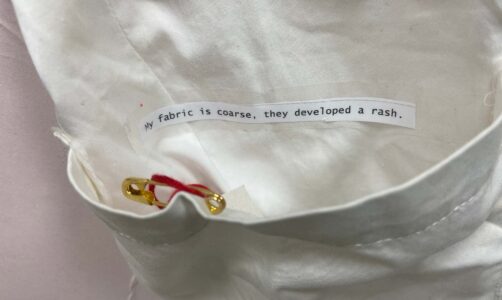Gossiping Clothes
Your clothes know your secrets.
How is that possible, they don’t communicate.
Maybe not with words but they speak
our values and it illuminate.
Where we belong, how we fit,
where we are from and who we know.
Our affiliations our delusions
our impulses and our foes.
Your clothes know your secrets.
What you wear shows who you are.
But that reality has been constructed,
it’s corrupted and bizarre.
Clothes have lost all utility
through language and capitalism.
Our identity is branding.
We are stuck in the system.
BUT Your clothes know your secrets.
They go with you every day.
They travel to places
they stay where you stay
But you don’t speak the language of your clothes
because FASHION lost touch with reality.
Human exceptionalism has primed us
to ‘other’ and designate frivolity.
BUT Your clothes know your secrets.
They know how you’ve spent
as little as possible,
buy cheaply, preserve every cent.
And this disposable habit comes
at the expense of others.
Identities fade,
and your wardrobe is a bother.
BUT IT’S DEEPER MUCH DEEPER THAN THAT.
Your clothes know who you are!
Every fibre is drenched with the sweat of your labour,
salty tears, smears of mud,
stains from the food we savour.
Your clothes are your second skin
your meat vessel has shelter.
Garments highlight your flaws,
tracks how bodies grow and wither
Your clothes also introduce their own secrets
They are dunked in chemicals, fasteners and dyes.
They are packaged, shipped and transported.
They end up on shelves for us to buy.
Produced by unfair treatment,
ecosystems and communities suffer.
The impact is immense,
instant gratification a buffer.
Your clothes also introduce their own secrets
Traversing the globe clothes easily accumulate
bacteria and micro-organisms
and on your skin, it incubates.
This bi-directional relationship
leaves scope for a new reality to thrive!
We shouldn’t look for the meaning of life,
we should seek an experience of being alive.
And your clothes can track your secrets
The latent ones you can’t voice
When you indulge or collapse.
When you move and rejoice
Wrinkling, chaffing and rubbing
intimate knowledge, your clothes’ effect is.
We need to change the relationship,
collect stories from the clothes perspectives.
Inspiration for this poem came after I read the two texts below:
Pask, E. (2017). Becoming a Leak.
[Online]. Available at: https://thenewinquiry.
com/becoming-a-leak/.
Accessed: 11 October 2021.
“On the one hand, conceptions of the stable body have served medical and legal ideas of identity well; the named and trackable self anchors birth certificates, passports, and other documents and acts as the primary marker of self and selfhood. On the other hand, our leaks can be manipulated by courts, labs, and other institutions that might want to control us. Because the legal protocols around ownership of biological data are often unclear, the biological information that leaks out of our supposedly bounded bodies is not necessarily ours to keep”.
Sanders, D., Grunden, A.,
Dunn, R.R. (2021). A Review of Clothing Microbiology:
The History of Clothing and the Role of Microbes in
Textiles. Biology Letters 17:1. [Online] Available at:
https://royalsocietypublishing.org/doi/10.1098
/rsbl.2020.0700.
Accessed: 13 April 2021.
The apparel we don has long since evolved beyond mere utility. Our fashion choices speak volumes about our personalities, but also our physiological tolerances.
Say what? I’m referring to the interplay between clothing, skin and the microorganisms that exist on them.
The skin is not only our largest organ it is also a habitat. Considerations are made for the bacteria from the fluids we excrete or the dirt we accumulate since this can judiciously be mitigated by washing and laundering. But we haven’t done a lot of studies to investigate how the act of wearing clothing has impacted the human microbiome – especially those living on our skin – and they are as ubiquitous as dust in the air!
The very first garments were probably animal hides and likely served as a mechanism for the transfer of microbes between garment and skin. As humans migrated to colder climates our dress became more sophisticated. A major transition occurred, about 30 000 years ago, when woven fabric, made from plant fibres was invented. Riding on the coattails of industrialization in the 19th century, synthetic fibres joined the ranks.
Mechanical interactions between the clothing and skin, especially friction and pressure, renders our skin a veritable breeding ground for bacteria. Friction leads to abrasions and tissue deformations. Textile dyeing and finishing can cause skin irritation. Moisture management, air permeability and heat regulation are strongly affected by fiber type, and all indicate that the choice of clothing could impact microbial communities. The origin of the first body lice lineage is often thought to have occurred with the introduction of clothes.
“Studies of skin microbes often find that only a small proportion of differences in microbial composition from one person to the next can typically be explained by demographic or genetic factors. Researchers suspect that some of the unexplained variation is due to differences in clothing type, clothing use and clothing effects. Clothing may favour microclimates and species that were uncommon prior to its invention and use” (Section 4).
“How did you get a UTI?” my friend asks. I was too embarrassed to admit that it was because I didn’t change out of my bathing suit after going swimming…for two days. No human person bore witness to my unhygienic behaviour, but something else was present – my clothes. Clothes go where our bodies go. They know the scintillating secrets we dare not share. But clothes know more than that. They also know the secrets behind the sinister industrial manufacturing process.
The triumph of most successful fashion brands lies not with their garments but with their story. Fashion brands sell an identity, an idea, and a lifestyle. The intrinsic status of owning a designer label or capricious indulgence of updating our wardrobes every season has more cultural value than a human life. Also, the material garment, the item that you buy to wear, is fundamentally obsolete since we don’t care about its function, only about what it symbolises. The story of ‘The Brand’ is so powerful and pervasive that we are anaesthetised to the garment’s material properties – the fibres of its threads, the meticulously sewn on buttons.
What if we shifted our perspective and paid more attention to the material garment’s stories? The stories of the bodies and the labour that made its existence possible. Do you think it is as glamorous as ‘The Brand’ stories? I’m afraid not.
The manufacturing process is skilfully hidden from us by the entities that financially benefit from exploitative practices (The Brand). The living bodies or ecological bodies are disembodied because we don’t discuss them as bodies that deserve rights. We discuss these bodies as resources, functions and processes. It is easy to exploit them when we don’t consider these bodies our equals.
Garments have memories of how the cotton they were spun from wiped out an ecosystem. They recall the person stitching their seams together suffered appalling working conditions. How can we as consumers be sure that the essence of the low paid farmers, garment workers, clothing designers or logistics personnel’s labour – their blood, sweat and tears – is not woven into the garment? Negative whisps of imperceptible energy could be flippantly entering our lives as we race to procure the latest ‘It’ items.
If this is indeed true, continuous overconsumption will lead to continuous strife. That stress or anxiety you feel about what you look like? That could be the affect of the trauma from the exploited ecosystems and labourers.
Suppose my speculation on affect theory, agency and relationality hold true. In that case, our lives are impacted by the suffering of other bodies, even though we are not directly complicit in causing their pain. By perpetuating the system that creates their suffering, negativity permeates everywhere.
Maybe if we realised our clothes knew dark secrets, we would treat them more respectfully. Perhaps if we realised they had agency and affected our lives, we would shop more consciously and sustainably and pay more heed to the ecological and living bodies in the fashion system.
The rhyme below is a quirky supposition of what our clothes might experience and know as they make their way from the farms into our wardrobes. It was one of my first rhyming academic works and served as the foundation for this whole thesis. I didn’t list it first as I thought it would have a more significant impact after explaining the theoretical concepts.
The rhyme scheme is ABACDED, so every second stanza rhymes. This poem is very melodic. I like the tempo and have subsequently turned it into a crude song.

On-Live Festival
On 19 October, I participated in the OnLive festival. This student-initiated festival gives artist to opportunity to translate their digital work into live performances or installations. The event focusses on intra-actoin and engagement within and between the parties and believe that it is spontaneity and participation that makes the ‘live’ so exiting.
For my contribution, I translated my poem, ‘Gossiping Clothes’ into an interactive installation.
"We often think we are alone, not being watched, but our clothes are always there to bear witness. Clothes know our secrets, but they also know the secrets behind the industrial fashion process and how exploitative it is the work invite people to leave their scandalous confessions in the pockets and folds of garments, but also subtly shines a light on some important social issues".
